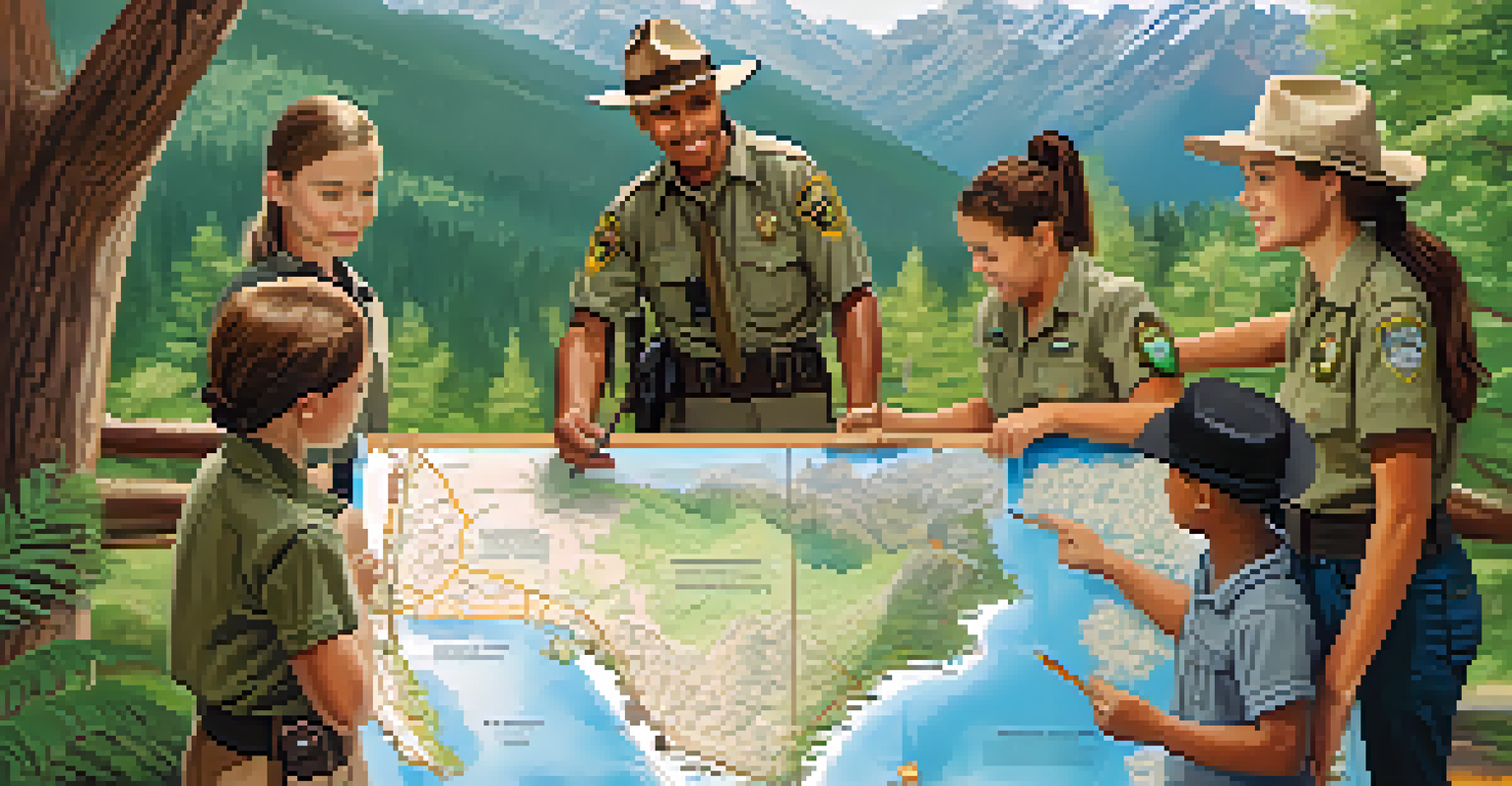Arizona's National Parks: A Gateway to Conservation

The Rich Diversity of Arizona's Natural Landscapes
Arizona is home to some of the most stunning national parks in the United States, showcasing a variety of ecosystems. From the towering cacti of Saguaro National Park to the dramatic canyons of Grand Canyon National Park, the state's landscapes are as diverse as they are beautiful. This diversity not only attracts millions of visitors each year but also plays a vital role in conserving unique flora and fauna.
In every walk with nature one receives far more than he seeks.
Each park serves as a living laboratory for scientists and researchers, helping to understand and protect the natural world. For instance, the unique geology of the Grand Canyon provides insights into Earth's history, while Saguaro National Park is essential for the preservation of the iconic saguaro cactus. These parks are not just recreational areas; they are crucial for environmental education and conservation efforts.
Understanding these landscapes helps us appreciate the importance of preserving them for future generations. By experiencing these environments firsthand, visitors can become advocates for conservation, promoting sustainable practices in their own communities. Ultimately, Arizona's national parks are a gateway to not only explore nature but also to protect it.
Key National Parks and Their Conservation Missions
Arizona boasts several national parks, each with unique conservation missions. For example, Petrified Forest National Park is dedicated to preserving one of the largest and most colorful concentrations of petrified wood in the world. On the other hand, Canyon de Chelly National Monument emphasizes the importance of both natural and cultural preservation, showcasing the ancestral lands of the Navajo people.

These parks work toward conserving biodiversity, protecting endangered species, and restoring natural habitats. The efforts include various initiatives, such as habitat restoration projects and wildlife monitoring programs, ensuring that these ecosystems remain balanced and thriving. Visitors often witness conservation in action, whether through guided tours or educational programs.
Diverse Ecosystems in Arizona Parks
Arizona's national parks showcase a rich variety of ecosystems, playing a critical role in conservation and education.
By supporting these initiatives through park visits or donations, individuals contribute to the ongoing mission of protecting these incredible landscapes. This symbiotic relationship between parks and people demonstrates how conservation can be a shared responsibility, making everyone an essential part of the solution.
The Role of Education in Conservation Efforts
Education is a cornerstone of conservation, and Arizona's national parks offer numerous programs to inform visitors. Ranger-led talks, interactive exhibits, and hands-on activities engage guests of all ages, helping them understand the delicate balance of ecosystems. By fostering a connection between people and nature, these educational initiatives inspire a sense of stewardship.
The environment is where we all meet; where we all have a mutual interest; it is the one thing all of us share.
For instance, the Junior Ranger Program allows children to explore the parks while learning about wildlife and conservation practices. This hands-on approach not only makes learning fun but also instills a lifelong appreciation for nature. When kids leave the parks, they carry with them valuable lessons that can influence their actions in everyday life.
Moreover, education extends beyond the parks themselves. Many parks collaborate with local schools and community organizations to promote environmental awareness and sustainability. By spreading knowledge about conservation, Arizona's national parks are nurturing the next generation of environmental advocates.
Community Involvement in Conservation Projects
Community involvement is vital for the success of conservation efforts in Arizona's national parks. Local residents, volunteers, and organizations often collaborate with park services to enhance preservation initiatives. This partnership fosters a sense of ownership and pride in the natural resources that surround them.
One notable example is the volunteer programs at Grand Canyon National Park, where community members assist in various tasks, from trail maintenance to wildlife monitoring. These hands-on experiences not only benefit the parks but also create lasting connections between volunteers and the environment. Such initiatives empower individuals to take action in their own backyards.
Community Involvement Enhances Conservation
Local residents and volunteers actively participate in conservation projects, fostering a sense of ownership and pride in preserving natural resources.
By engaging communities, parks can tap into local knowledge and resources, enriching conservation strategies. This collaborative approach ensures that conservation efforts are inclusive and reflect the values and needs of the community, ultimately leading to more effective outcomes for the environment.
The Impact of Climate Change on Arizona's Parks
Climate change poses significant challenges to the ecosystems within Arizona's national parks. Rising temperatures, prolonged droughts, and shifts in precipitation patterns can disrupt the delicate balance of these natural habitats. For instance, the increased frequency of wildfires threatens the survival of various plant and animal species.
Park officials are actively monitoring these changes and implementing adaptive management strategies to mitigate their impact. This includes restoring habitats, managing invasive species, and developing fire management plans. Public awareness and advocacy are also crucial, as they encourage sustainable practices that can help combat climate change.
Visitors can play an essential role in this effort by practicing responsible tourism, such as staying on designated trails and minimizing waste. By understanding the effects of climate change on these parks, we can collectively work toward preserving these natural wonders for generations to come.
Sustainable Tourism Practices in National Parks
Sustainable tourism is increasingly important in preserving the integrity of Arizona's national parks. As visitor numbers rise, so does the need to minimize the impact on the environment. Sustainable practices, such as reducing waste and conserving resources, help protect these fragile ecosystems while allowing everyone to enjoy their beauty.
Many parks have adopted initiatives to promote eco-friendly behaviors among visitors. For example, educational signage encourages recycling and proper waste disposal, while programs like carpooling and shuttle services reduce carbon footprints. By embracing these practices, visitors can contribute to the preservation of these natural treasures.
Climate Change Challenges National Parks
Arizona's national parks face significant threats from climate change, prompting adaptive management strategies to protect vulnerable ecosystems.
Additionally, local businesses are increasingly adopting sustainability practices, from eco-friendly accommodations to responsible tour operations. When travelers choose to support these businesses, they help create a positive impact on the local economy and environment, ensuring that Arizona's national parks remain vibrant and accessible for years to come.
The Future of Conservation in Arizona’s National Parks
The future of conservation in Arizona's national parks looks promising, thanks to ongoing efforts from park services, communities, and visitors alike. As awareness of environmental issues grows, more people are becoming involved in conservation initiatives, fostering a culture of stewardship. This collective commitment to protecting these natural treasures is essential for their survival.
Innovative conservation strategies, such as the use of technology for monitoring wildlife and ecosystems, are also being implemented. These advancements allow for more effective data collection and analysis, enabling park officials to make informed decisions regarding conservation efforts. The integration of technology with traditional conservation methods creates a comprehensive approach to preserving these unique landscapes.

Ultimately, the success of conservation in Arizona's national parks relies on collaboration and education. By working together and sharing knowledge, we can ensure that these incredible environments continue to thrive, providing enjoyment and inspiration for future generations.